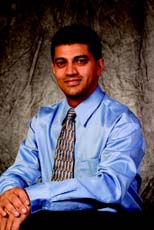|
Issue Date: May 2006
Creative Visions Foundation
As various market and policy forces change, providers are gravitating to EMR environments.
Mark Hagland
James Holly, M.D., CEO in the Southeast Texas Medical Associates (SETMA) group in Beaumont, Texas, knows exactly why his organization implemented an electronic medical record (EMR) system for the 24-physician, 260-staff-member medical group. It's all about optimizing patient care quality and empowering physicians - and not, he repeats, not about simply automating processes.
"What compelled us, and it was a compulsion, to move into an electronic record system, which very quickly morphed into what we call electronic patient management, was the ability to analyze patient care and provide decision support at the point of care," Holly says. "As we provide decision support at the point of care, then it's worth the cost, and it's worth the hassle" of EMR implementation.
"As we developed a multispecialty group," he adds, "we realized that to maintain quality and improve efficiency, it would take more than paper records. And once we decided to do it, we decided to do it well and excellently."
For SETMA's electronic patient management system, which helps support specializations in diabetes and hypertension care, the group was given the Nicholas E. Davies Award of Excellence for ambulatory care in 2005, from the Chicago-based Healthcare Information and Management Systems Society (HIMSS). SETMA's system is a customized version of the ambulatory EMR product from Horsham, Pa.-based NextGen Healthcare Information Systems.
It's for the same kinds of reasons that 24-hospital Trinity Health System has spent $315 million so far to create a comprehensive system-wide EMR, says Narendra Kini, M.D., senior vice president of clinical operations improvement at the Novi, Mich.-based system, which spans seven states.
Improved patient care and optimized workflow, along with increased physician and nurse efficiency, are all top of mind for Kini and his colleagues. By 2009, Kini says, all 24 hospitals will be live with computerized physician order entry (CPOE) - nine are live so far. When completed, Trinity Health System's EMR will be the largest of its kind in the nation outside the Veterans Administration and Kaiser Hospitals, Kini points out.
Some might be surprised that such a comprehensive and assertive implementation is taking place across a non-academic, multi-hospital environment; and, Kini confirms, it is more difficult to achieve full-fledged EMR with CPOE in a non-academic environment. But, he says, "The aggregate rate of adoption in our system is now about 70 percent, and that's substantially higher than most hospital systems are maintaining," post-rollout.
The key, he says, is the intensive process and workflow analysis and preparation that must be made before actual EMR implementation, a phase that has required two years at each Trinity facility. Kini adds that many hospital leaders have until recently either failed to correctly estimate the pre-implementation time and effort required, or been unwilling to invest in the financial and human resources to prepare successfully for EMR implementation.
What might surprise many in healthcare is the seemingly sudden acceleration in EMR implementations on the part of whole new categories of patient-care organizations nationwide. Though the EMR has been talked about and predicted for decades, only a handful of mostly academic institutions - large urban teaching hospitals, for the most part - had fully implemented EMRs, and few physician groups had created anything close to a comprehensive outpatient EMR. Numerous reports of high-profile flame-outs, most famously the one several years ago at Cedars-Sinai Medical Center in Los Angeles, may have also negatively affected adoption rates.
A new day for EMRs?
But a variety of market and policy forces are changing the landscape, says Trinity's Kini. "There is now sufficient momentum coming from the payers, federal government and market. Are we at a tipping point for the medical record? We are at a tipping point for order entry, and for documentation; I'm sure that we're at a tipping point for decision support."
Another key change in the past few years has been the realization that core operational performance and efficiency will depend on the implementation of EMRs in hospital organizations and medical groups, says Lewis Redd, managing partner in the North American Provider Practice of Accenture. For innovative academic medical centers and other patient care organizations, the point is not implementing specific vendor products, says Redd, "It's about clinical transformation. These hospitals are looking for operational and quality improvements. Eight years ago, it was all about cost reduction," says the Atlanta-based Redd. "Now, the agenda is, I need to improve my quality outcomes; I need to grow my market share; I need to have differentiable service results; and I need financial longevity."
The EMR is no longer seen as a "nice," "optional," or "idealistic" innovation, but rather an essential tool to achieve higher operational, clinical and financial performance, he says. Not surprisingly, Redd adds, CEOs, chief medical and nursing officers, and other senior executives are now fully engaged in facilitating EMR implementations.
Results from the HIMSS Leadership Survey seem to affirm the momentum toward EMR progress. Twenty-four percent of IT executive respondents told HIMSS this year that they had implemented some form of EMR, compared to 18 percent last year. Meanwhile, 87 percent have or plan to purchase an EMR. And once again this year, HIMSS Leadership Survey respondents cited the EMR as one of the top applications to be implemented.
Meanwhile, a study by Redwood Shores, Calif.-based Oracle Corporation found that 85 percent of senior hospital executives expect to implement EMRs in the next five years.
What's Driving EMR Adoption?
According to James Holly, M.D., CEO and managing partner in the Southeast Texas Medical Associates (SETMA) group in Beaumont, Texas, it's:
- pressure from payers for physicians to provide accurate clinical information for billing purposes;
- increased emphasis on patient safety;
- the rapidly expanding universe of clinical knowledge needed to provide care;
- an increasing need to care for a large number of patients with chronic illnesses;
- and pay-for-performance and other accountability-based payment and outcomes measurement systems.
"Doctors are beginning to see that they can't do all this with paper records," he says.
Mychelle Mowry, R.N., vice president for Oracle's Global Health Industries, says she's not surprised by the survey's findings. "I think that, particularly when you look at how many folks are actively involved in RHIOs (regional health information organizations), which is a step beyond electronic health records, we are at a tipping point," says the Evergreen, Colo.-based Mowry.
The question of how rapidly implementation will take place is a complicated one, however, says Trinity's Kini.
Preparation is key
"One of the major learnings from our experience is that you need a substantial period of time to prepare readiness" for an actual implementation," Kini says, preparations that include getting ready for the build itself, training clinicians and staff, redesigning workflow, and changing the paper-based mentality. "And I will tell you that our readiness process extends almost 24 months before go-live." Kini's estimate of nationwide EMR adoption and successful implementation: 10 years from now.
His assessment is backed up by new findings from HIMSS Analytics, Chicago, the research arm of HIMSS. In a report titled "Healthcare IT Trends and Glimmers" that was released in early February, the group examined EMR progress, among other issues. And, based on a schematic for EMR development created by Dave Garets, the Blaine, Wash.-based president and CEO of the research group, a low level of advancement is evident.
His schematic postulates seven distinct, sequential stages of EMR development, from stage zero of no development, to an ideal stage seven that no healthcare organization has yet reached. Stage seven involves not only a complete EMR but an electronic health record (EHR) that is facilitated by the EMR (and which will be necessary for connectivity with RHIOs).
According to the schematic, 0.1 percent of hospitals have full physician documentation that includes structured templates, along with complete clinical decision support, including variance and compliance tools and a full picture archiving and communications system (PACS) together (stage six); another 0.5 percent have closed-loop medication administration (stage five); and 1.9 percent have CPOE and clinical protocols in place (stage four).
"We were surprised that we didn't see bigger numbers in the higher stages; we were surprised at the number of organizations that were at levels 0 and 1" in the schematic, says Garets. But he defends the sequential-development assumption of the group's schematic, saying that it's virtually impossible to get to a more advanced stage of EMR development unless one has all the elements in place from the earlier stages.
What makes the HIMSS Analytics study different are both its more rigorous and detailed definitions of progress, and the fact that Garets and his colleagues personally validated responses with individual hospitals.
"The take-away from this study is adoption of electronic medical records in the United States," Garets says. "Three-fifths of the organizations in the country are on the road, and they're doing it with demonstrated implementations of an EMR. But 39 percent aren't far enough along to have the core functionality implemented, and that's a clinical data repository," which is essential to a comprehensive EMR, he says. "So we're making progress, but we've got a long way to go."
EMR and accountability
Broadly speaking, the biggest spur to EMR development will be the continuing emergence of a new level of accountability in healthcare, says Jane Metzger, research director in the Emerging Practices Unit of Long Beach, Calif.-based First Consulting Group.
"We're really entering an era of accountability, and there's huge public awareness of incidents that can happen in hospitals. And there seems to be a slowly growing awareness that all care is not equal."
The healthcare industry is converging on quality metrics as a market differentiating tool, the Boston-based Metzger says. Pay-for-performance programs - in which many hospitals and physician groups are already participating, either through the Medicare program's demonstration project or through private payers - are going to be major drivers of EMR development, because of the intensive needs for data they engender, she adds.
In addition, says John Quinn, a senior executive at Accenture, "We're already near a tipping point in some areas, (such as) those with large integrated delivery networks like the Cleveland Clinic and Kaiser. Because those large organizations are already investing in EMRs, they're pulling communities along with them," says the Cleveland-based Quinn. "The challenge remains money to pay for all this, which isn't going to come from Congress."
Lyle Berkowitz, M.D., a practicing internist in Chicago and an IT expert and part-time consultant, says funding obstacles will remain significant, even more so for physicians than for hospitals.
On the other hand, he sees a strong "domino effect" taking place in individual healthcare markets. "Once one hospital starts offering EMR systems to the local physicians, the others will have to do something similar, making it the cost of doing business in the neighborhood." The first hospital or two in a market will also gain "first-mover advantage," further spurring adoption, he predicts.
Meanwhile, Berkowitz says most physicians recognize that they will need to participate in EMRs, but remain uncertain as to how automation will affect the way they practice.
For organizations like Southeast Texas Medical Associates, there's no question that the future has already arrived. In fact, Holly cites Peter Senge's book, when he says, "The Fifth Discipline was a page-turner for me. One of the things he talks about is that we have the capacity to produce more information than anybody can process, the ability to create change faster than anyone can keep up with, and the ability to produce interactions that are impossible for anyone to analyze. We're already at that point now in patient care."
|